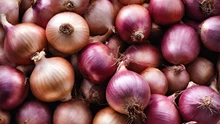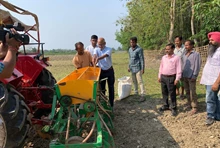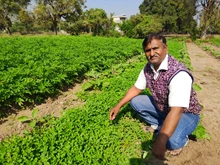
Innovations in farming community has seen rise in productivity in the last few years. In 1798, economist Thomas Malthus predicted that the world would exceed its food supply by the late 20th century. There are numerous challenges faced by farming community to feed the increasing population. In the last half century agricultural production has tripled. So, how did this happen?
After a wide range of surveys one answer came out and that was the ‘Innovations’ which has paved the way for success in agriculture.
1. Fertilizer deep placement
The right placement of fertilizer is an important factor for the growth and production of crops. In Nigeria, FDP is used by farmers. Fertiliser deep placement (FDP) is a new way of distributing fertiliser that increases small holder yields by an average of 18% and reduces fertiliser use by a third. Traditionally, rural farmers apply fertiliser to crops by spreading the seeds by hand. FDP works by using a specialised fertiliser (called 'briquette') which releases nitrogen gradually. The fertiliser is placed 7-10 centimeters below the soil, which allows less nitrogen to be lost through runoff.
2. Mobile apps
Mobile apps are the latest technological interventions nowadays which have not only changed the lives of farmers but enhanced the working ability in an innovative ways. There are numerous examples, which are helping farmers in not only diagnosing the diseases in livestock but also in plant diseases enabling them to provide right amount of fertilizer and irrigation inputs.

3. New feeding systems
Now feeding the livestock is no more as simple as it was before as it is now used to be weigh and ratio and proportions need to be fixed which leads to the proper nutrition of these livestocks. Using a 'total mixed ration' has been found to reduce labour costs, increase animal health and give farmers greater flexibility with feed ingredients. All these factors together improve farm profitability by reducing feed costs - which make up 60-70% of total farm costs - and maximise milk production.
4. Farm management software and training
No innovations are possible in isolation, so is the requirement for farm management training in software and other aspects that calculates food rations and milking systems to make farm management as simple as possible. These trainings in different aspects have provided benefits in different sectors to farmers to enhance their growth and productivity along with productivity of livestock.

5. High roofed greenhouses
Greenhouses with roofs of 12 feet or higher, which has been shown to double farmers' yields has been created at some places. Because of government restrictions, farmers in Turkmenistan often do not have access to large areas of land. Greenhouses are a great way to increase production, although a traditional greenhouse can only grow short tomato and cucumber plants.
6. Dairy hubs
This has been a successful venture in dairy field in Bangladesh and Pakistan and now been trialed in India and East Africa. Through dairy hubs farmers can keep record to dairy processors, cutting costs and putting money back into local communities. Through this model, farmers gain higher income, education and healthier animals, while the production of safe and affordable milk in developing countries increases.











